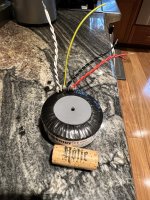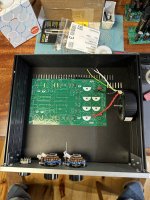Hi George,
Your last post was wonderful! It painted a picture that penetrated my thick head.
Thanks!

Edit: link for socket headers that fit TO-220
https://a.co/d/fPx7Slq
Your last post was wonderful! It painted a picture that penetrated my thick head.
Thanks!

Edit: link for socket headers that fit TO-220
https://a.co/d/fPx7Slq
Last edited:
As mentioned, those will not fit the fat pins on a TO-220.@ra7 are you looking for these sockets - https://www.amazon.com/dp/B0778TFL39?psc=1&ref=ppx_yo2ov_dt_b_product_details. I got these to test the jfets but seems like we can use even the to220 mosfets too.
These will work, but you need to cut them up. I use wire cutters to cut through the 4th pin then to clean up the jagged edges.
https://www.amazon.com/ZYAMY-2-54mm-Female-Straight-Connector/dp/B0778F2MLW
The "magic" block on my diagram in post #950 is essentially a variable width door that can open and close faster than the highest possible frequency in the program material. It stays nearly closed (set for a watt or two of output power) but can open faster than the amp can make power, providing just enough headroom to avoid clipping.Hi George,
Your last post was wonderful! It painted a picture that penetrated my thick head.
Thanks!
I built a working prototype back in 2008, but lost interest. I have recently dug out the old circuit board, but I can't find the code I wrote for the controller chip yet.
If I have to start over, I will either go with an all hardware circuit, or attempt to use a high powered Arduino compatible CPU board. I need an A/D that's at least 16 bits preferably with a sample rate of 1 MHz or faster.
Tubelab - there is something funny about your link.
At least on my machine - it goes somewhere other than AMAZON.
Must be something about DIYAUDIO
If you copy the link, being careful so you do not engage the link, you can get to where you intended it to go
At least on my machine - it goes somewhere other than AMAZON.
Must be something about DIYAUDIO
If you copy the link, being careful so you do not engage the link, you can get to where you intended it to go
If I recall comments from Nelson Pass accurately this topology brings together two quite linear stages that reduce the influence of the chosen devices; common drain and common gate. So what drives the choice of the devices as it would appear quite a nuanced decision by comparison with perhaps a common source stage?
Secondly, given the typical preference given to Jfet devices is there anything to be `gained' by using jfets instead of mosfets?
for example Linear Integrated systems offer LSJ74 & LSK170 and the corresponding duals... (Aside from the `low cost' comment in the original mission statement)...
Secondly, given the typical preference given to Jfet devices is there anything to be `gained' by using jfets instead of mosfets?
for example Linear Integrated systems offer LSJ74 & LSK170 and the corresponding duals... (Aside from the `low cost' comment in the original mission statement)...
Great question. The p-channel choice was based on what I had on hand and were plentiful at the usual sources. Several other devices could be substituted without much affect on the sound because it operates in follower mode.
The gain FET is much more important and I tried a number of devices, nearly all the usual suspects, including JFETS. The few properties the gain device should have are: ability to sustain about 40V and 10 mA at the minimum, lowish capacitance, and good sound of course. A schematic with lsk170 and some listening impressions are here.
The smaller devices struggle to drive VFET gates directly but might be fine driving, say, Papa’s 2022 FE. The STP30N10F7 sounds really good and meets all the other requirements. I tried a lot more FETs but that device is yet to be dethroned. Measures really well too.
I am working on an output buffer that could drive headphones and that will open up smaller devices in the gain position.
The gain FET is much more important and I tried a number of devices, nearly all the usual suspects, including JFETS. The few properties the gain device should have are: ability to sustain about 40V and 10 mA at the minimum, lowish capacitance, and good sound of course. A schematic with lsk170 and some listening impressions are here.
The smaller devices struggle to drive VFET gates directly but might be fine driving, say, Papa’s 2022 FE. The STP30N10F7 sounds really good and meets all the other requirements. I tried a lot more FETs but that device is yet to be dethroned. Measures really well too.
I am working on an output buffer that could drive headphones and that will open up smaller devices in the gain position.
Last edited:
Hi everyone
I tried to search but might have missed this info.
Digikey is out of the fqp12p20. Is there a drop-in substitute for this?
Thanks for any advice
I tried to search but might have missed this info.
Digikey is out of the fqp12p20. Is there a drop-in substitute for this?
Thanks for any advice
I would consider FQP9P25 (currently available at Digikey): https://www.digikey.ca/en/products/detail/onsemi/FQP9P25/1055385
There appears to be stock of the FQP mosfets in the UK. If these are worth getting, then they are available...
in eBay Germany you can find 10pcs ( 15€) New Transistor Fairchild FQP12p20 P QFET 200V 11.5A # the source is reliable
https://www.ebay.com/itm/3637928294...qNewOtLQ/owEjz8BYh4kl8E6A=|tkp:Bk9SR5ax3ojMYQ
https://www.ebay.com/itm/3637928294...qNewOtLQ/owEjz8BYh4kl8E6A=|tkp:Bk9SR5ax3ojMYQ
Conrad asks about 7 €/piece and you can't order privately from the other two, you need a tax identification number!
They don’t ship to US….good link though. Thxin eBay Germany you can find 10pcs ( 15€) New Transistor Fairchild FQP12p20 P QFET 200V 11.5A # the source is reliable
https://www.ebay.com/itm/363792829458?hash=item54b3be0c12:g:zBoAAOSwb79j6ezD&amdata=enc:AQAHAAAAoHtIaDc37qHDnC8PjCwGurzRAc+kw0j7Zfy7/neLLfLSeB5CiFzUKpo+n9V1DbYUzA0NeSuW95aTz2boKR4cV7HCvSQrqQiF38axDi+dOobX0A0cZpBRjHw+UcRfRbJJVJ1BDVMK+tDk9dhOGbfRePByq/ymRZV1qL1Q5JL2ESGvw1xd6xzybEg4Iw1m1rqNewOtLQ/owEjz8BYh4kl8E6A=|tkp:Bk9SR5ax3ojMYQ
Manniraj asked about a replacement for the p-channel part a few posts ago. Several recommendations were made. See my post and George and others before it:
https://www.diyaudio.com/community/threads/schade-common-gate-scg-preamp.380487/page-40#post-7226841
There 11,000 fqpf9p25 in stock at Mouser. Will work just fine.
https://www.diyaudio.com/community/threads/schade-common-gate-scg-preamp.380487/page-40#post-7226841
There 11,000 fqpf9p25 in stock at Mouser. Will work just fine.
Just wondering whether boards are available yet.@rolotube, others who want a PCB. I just placed an order for 10. Should have them in a couple of weeks.
- Home
- Amplifiers
- Pass Labs
- Schade Common Gate (SCG) Preamp

